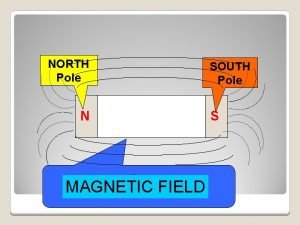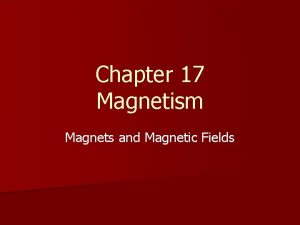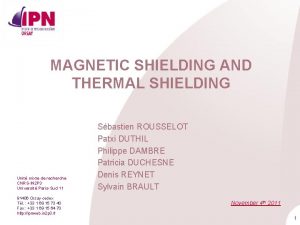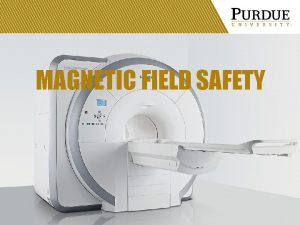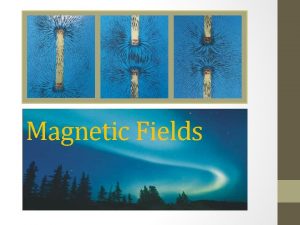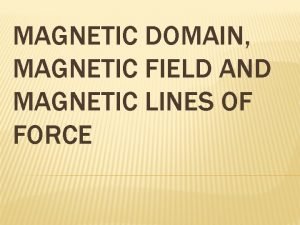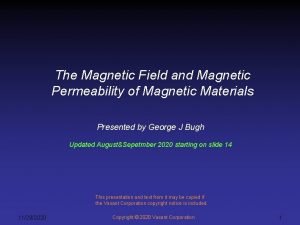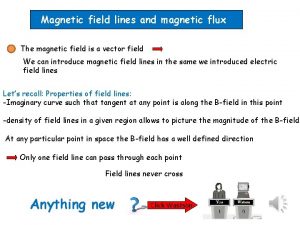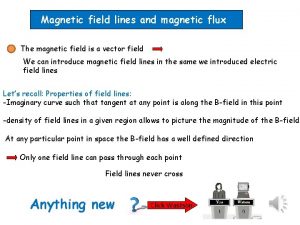Magnetic Shielding and Creation of homogeneous magnetic field









- Slides: 9

Magnetic Shielding and Creation of homogeneous magnetic field (1 st presentation) Research student: Gustavo A. Gandara Montano Supervisor: Bertalan Juhasz ASACUSA Collaboration Thursday July 8 th, 2010. Rm 160 -1 -009 at CERN. Geneva, Switzerland

The Big Picture The ASACUSA Collaboration is trying to measure hyperfine splitting of Antihydrogen Need for Static Magnetic Fields *Hyper. Physics Inhomogeneity of 1% Inhomogeneity of 0. 2% * B. Juahasz, E. Widmann

What I am trying to do: RF cavity: Radius of 210 mm Length 100 cm Region of Homogeneity: Radius: 100 mm Length: 105 mm (HAW) Initial Situation Inhomogeneity of 44. 28%

How to produce the homogeneous Field? Garrett Coils Smaller Garrett Coil: Laying along Y axis, it exists inside a sphere of 261 mm Larger Garrett Coil: Laying along Z axis, it exists inside a sphere of 311 mm For both Garret Coils to produce the same magnetic field at the center. The external Coil must have a current larger by a factor of 1. 19157

An inherent problem with the shielding Graphs created by the Garret Coils and cylinders laying along Z-axis ONLY Mu metal Soft Iron *The Garret Coils would create a field of 3. 0 G in this set up

First geometry: Cusp Trap Shielding and cylinder laying along z-axis surrounding the cavity The parameters of the cusp trap shielding that gave the less external field in the region of homogeneity were: A length of 100 mm, a location of -550 mm and a Radius of 1000 mm. (This gave a |B| of 0. 39697 G at {50, 0, -53}) * You have to optimize the whole setup at the same time!!!

Optimization with several configurations Cylindrical Shielding along Z with both shieldings made of mu metal RF shield parameters: Length: 600 mm Radius: 348 mm Cusp Shielding: Length: 20 mm Located at: -950 mm Radius: 500 mm Inhomogeneity of 3. 39 % Box Shielding RF shield parameters: Length: 666. 6 mm XY length: 700 mm Cusp Shielding: Length: 20 mm Located at: -900 mm Radius: 500 mm Inhomogeneity of 10. 3 % * I added en extra layer (a box within a box) to the most efficient shielding (of length 776 and XY length 800) and it didn’t help

A most efficient configuration of the Garrett Coils Smaller Garrett Coil: Laying along Z axis, it exists inside a sphere of 250 mm Larger Garrett Coil: Laying along Y axis, it exists inside a sphere of 300 mm * In external coil there must be a current 1. 2 times larger than in the internal one * As I was getting too close to the sextupole, I had to move it (700 mm) Optimizations Shielding along Z-axis Cusp Shielding: Radius=500 Length=270 Location=-800 RF shielding: Radius 650 mm Length=776 Shielding along X-axis Cusp Shielding: Radius=500 Length=220 Location=-850 RF shielding: Radius 550 mm Length=776 {x, 0, z} plane {0, y, z} plane Inhomogeneity of 0. 6 % in YZ plane Inhomogeneity of 0. 91 % in YZ plane. * It can still be further optimized

Bibliography B. Juhasz. Radiofrequency Cavity for the Measurement of the Ground- State Hyperfine Splitting of Antihydrogen. Stefan Meyer Institute for Subatomic Physics. February 2009 B. Juhasz, E. Widmann. Planned Measurement of the Ground-state Hyperfine Splitting of Antihydrogen. Stefan Meyer Institute for Subatomic Physics. Springer Science & Business Media. August 2009 M. Garrett. Axially Symmetric Systems for Generating and Measuring Magnetic Fields. Journal of Applied Physics Vol: 22 Number: 9. September 1951 The Hydrogen 21 -cm Line. Hyper. Physics. Department of Physics and Astronomy of Georgia. State University Thank you for your attention Any questions
 Definition of homogeneous differential equation
Definition of homogeneous differential equation Magnetic moment and magnetic field relation
Magnetic moment and magnetic field relation Weber magnetic field
Weber magnetic field F=i(lxb)
F=i(lxb) Magnitude of magnetic force
Magnitude of magnetic force Electric field and magnetic field difference
Electric field and magnetic field difference Difference between electric field and magnetic field
Difference between electric field and magnetic field Hysteresis loop magnetism
Hysteresis loop magnetism Characteristics of a magnetic field
Characteristics of a magnetic field Force exerted by magnetic field
Force exerted by magnetic field








